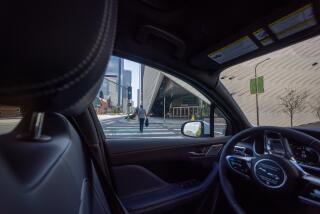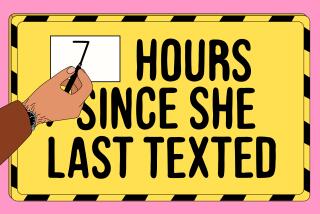Texting, dialing while driving raise crash risk, study confirms
- Share via
A sophisticated, real-world study confirms that dialing, texting or reaching for a cellphone while driving raises the risk of a crash or near miss, especially for younger drivers. But the research also produced a surprise: Simply talking on the phone did not prove dangerous, as it has in other studies.
This one did not distinguish between hand-held and hands-free devices — a major weakness.
And even though talking doesn’t require drivers to take their eyes off the road, it’s hard to talk on a phone without first reaching for it or dialing a number — things that raise the risk of a crash, researchers said.
Earlier work with simulators, test tracks and cellphone records suggests that risky driving increases when people, especially teens, are using cellphones. People ages 15 to 20 account for 6% of drivers but 10% of traffic deaths and 14% of police-reported crashes with injuries.
For the new study, researchers at the Virginia Tech Transportation Institute installed video cameras, global positioning system devices, lane trackers, gadgets to measure speed and acceleration, and other sensors in the cars of 42 newly licensed drivers 16 or 17 years old and the cars of 109 adults with an average of 20 years behind the wheel.
The risk of a crash or near miss among young drivers increased more than sevenfold if they were dialing or reaching for a cellphone and fourfold if they were sending or receiving a text message. The risk also rose if they were reaching for something other than a phone, looking at a roadside object or eating.
Among older drivers, only dialing a cellphone increased the chances of a crash or near miss. However, that study began before texting became so common, so researchers don’t know whether it is as dangerous for them as it is for teens.
The National Institutes of Health and the National Highway Traffic Safety Administration paid for the research. Results were published Thursday in the New England Journal of Medicine.
David Strayer, a University of Utah scientist who has done research on this topic, said the finding that merely talking on a phone while driving was not dangerous was “completely at odds with what we found.”
The study methods and tools may have underestimated risks because video cameras capture wandering eyes but can’t measure cognitive distraction, he said.
“You don’t swerve so much when you’re talking on a cellphone; you just might run through a red light,” and sensors would not necessarily pick up anything amiss unless a crash occurred, Strayer said.
As for texting, “we all agree that things like taking your eyes off the road are dangerous,” he said.
At least 12 states ban the use of hand-held cellphones while driving, and 41 ban text messaging. Any cellphone use behind the wheel is banned by 37 states for novice or teen drivers, says the National Conference of State Legislatures, citing information from the Governors Highway Safety Administration.
More to Read
Inside the business of entertainment
The Wide Shot brings you news, analysis and insights on everything from streaming wars to production — and what it all means for the future.
You may occasionally receive promotional content from the Los Angeles Times.










